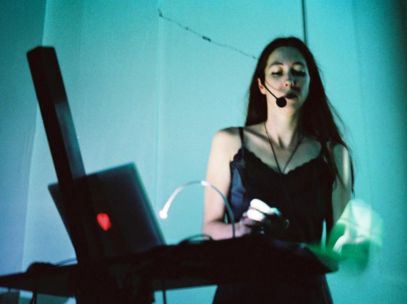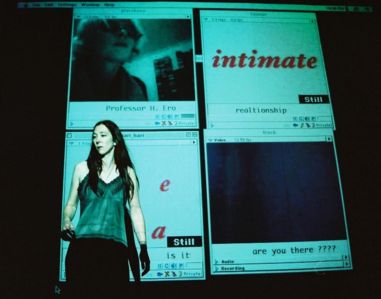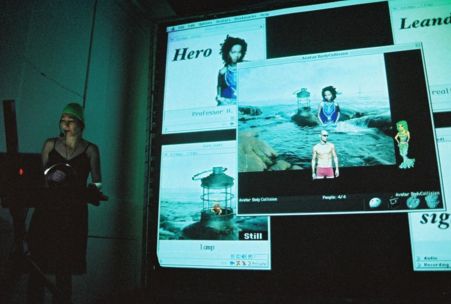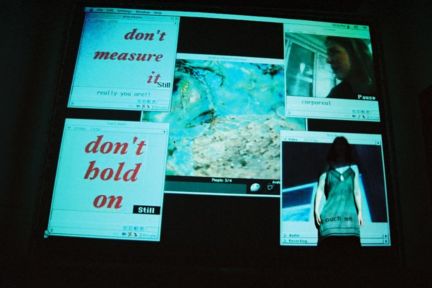Avatar Body Collision presents
s w i m
an exercise in remote intimacy
at Mesto Zensk - City of Women
Galerija Kapelica, Ljubljana,
Slovenia
14 October 2003
photography by Nada Zgank
Helen's attendance at Mesto Zensk was assisted by a grant from Creative
New Zealand.
 |
|
"swim" is a live performance by four players for an off-line audience. One person appears on stage in the venue with the proximal audience, while the other three perform remotely, using the internet and chat technologies to appear on a screen. Everything takes place in real time, nothing has been pre-recorded. "I'm going to a party. For a moment, it crossed my mind that I had to pick you up. But I can't." The performance begins with the "Laptop Dance", after which the onstage performer (Helen Varley Jamieson) connects to the internet and finds her remote collaborators in chat rooms in cyberspace. |
 |
|
From her London home, Karla Ptacek appears as online academic Professor H. Ero and delivers a lecture about a groundbreaking cyberformance, as Helen performs it on stage. "During the performance, the artist will approach a web cam and slowly unbutton and remove the leather coat to reveal the petticoat. She may or may not wear a wig - this will be a spur of the moment decision and will represent the spontaneity of the cyber-relationship. The protective, prophylactic presence of the leather coat juxtaposed with the intimate vulnerability of the petticoat symbolises the dichotomy of public and private in cyberspace, the simultaneous safety of distance and danger of exposure of the heart on(the)line. That the artist is naked underneath the petticoat symbolises absolutely nothing but is purely to enhance the erotic effect for the voyeur." The other two remote performers (Leena Saarinen in Finland and Vicki Smith in Aotearoa) contribute word images that underline the theme of the lecture. |
 |
|
In the Palace (graphic/sonic chat application), the avatars tell the story of Hero and Leander, lovers from Greek mythology who must swim across the Dardanelles to be together. The nightly swimming is a metaphor for the journey across cyberspace. The web cam windows show jpegs of the avatar being operated by each remote performer. On stage, Helen prepares for the next scene by donning a swimming cap and goggles, while on screen the avatars enact the tragic ending of Hero and Leander's love. |
 |
|
The four performers begin to swim towards the idea of love, but Helen suffers the same fate as Leander, with a virtual drowning. The remote performers must act quickly to save her. Luckily, they come up with the Maori legend of Hinemoana and Tutanekai, which offers a more optimistic future for aquatic lovers and brings Helen back to life. With the understanding that people in cyberspace are also be real, that cyber-relationships are between real people, the human faces behind the avatars reappear in their web cam windows. |
 |
|
Acknowledging the temporeality and transience of cyberspace, Helen gives sage advice on such relationships: "Don't measure it. Don't mourn it when it's gone. Don't hold on." Different technical challenges arise in every performance, and in this performance in Ljubljana, Leena experienced lag (for the first time!), causing her web cam image to freeze instead of displaying a word jpeg. |
 |
|
The remote players disconnect, leaving Helen alone onstage. She closes her computer, balances it on her head, and leaves the stage after delivering her final lines - an echo of the lines at the start of the performance: "We're going to a party. For a moment, it crossed my mind that I had to pick you up. But - you are here." |